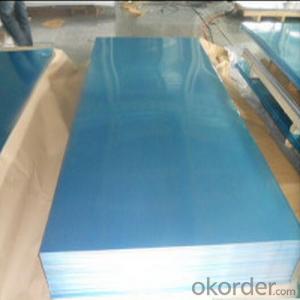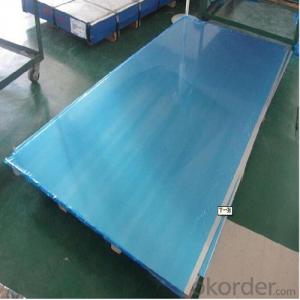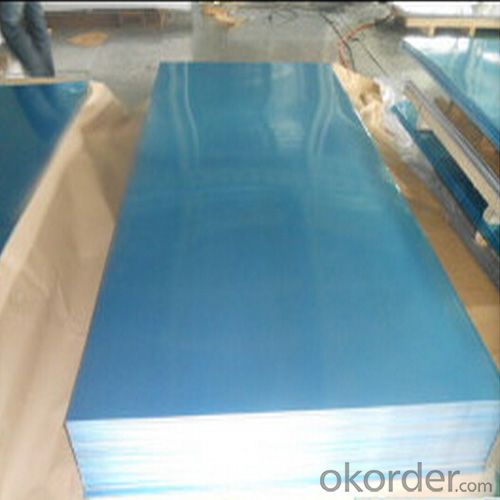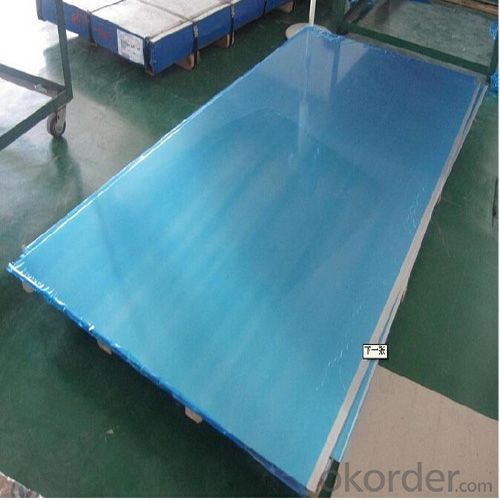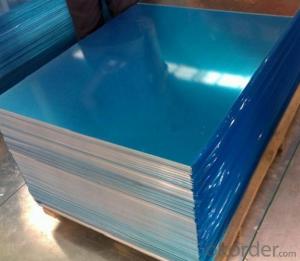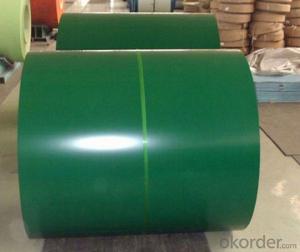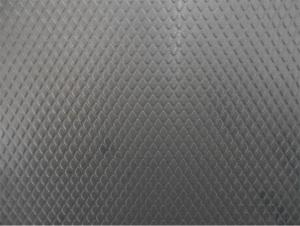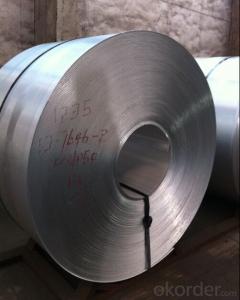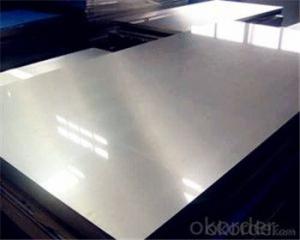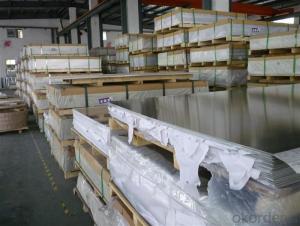High Quality Camo Aluminum Sheets with Plastic Film Coated
- Loading Port:
- Shanghai
- Payment Terms:
- TT OR LC
- Min Order Qty:
- 5 m.t.
- Supply Capability:
- 10000 m.t./month
OKorder Service Pledge
OKorder Financial Service
You Might Also Like
Specification
1.Structure of Plastic Film Coated Aluminum Sheet Description:
Plastic Film Coated Aluminum Sheets are widely used for building use, decoration use, making cookware, busing making, shipping building, airplane making and so on。Sizes of aluminum sheet for decoration use: Thickness: 0.3mm~300mm Width: Under 2000mm ( Standard: 1000mm, 1219mm, 1500mm, 1540mm) Length: Under 10000mm. Products commonly used in signs, billboards, building exterior decoration, bus body, high factory wall decoration, kitchen sink, lamp, fan, electronic components, chemical apparatus, sheet processing, deep drawing or spinning hollow ware, welding parts, heat exchangers, Bell surface and plate, plates, kitchen utensils, accessories, safety equipment and other.
2.Main Features of Plastic Film Coated Aluminum Sheet:
Reasonable and stable chemical composition
Accurate tolerance
Nice mechanical property
Standards: EN, ASTM and JIS
3. Plastic Film Coated Aluminum Sheet Images:
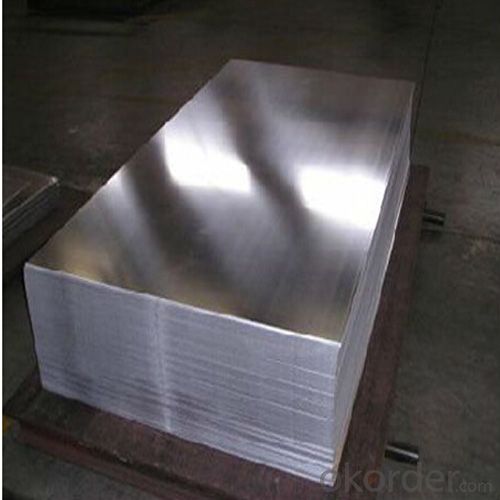
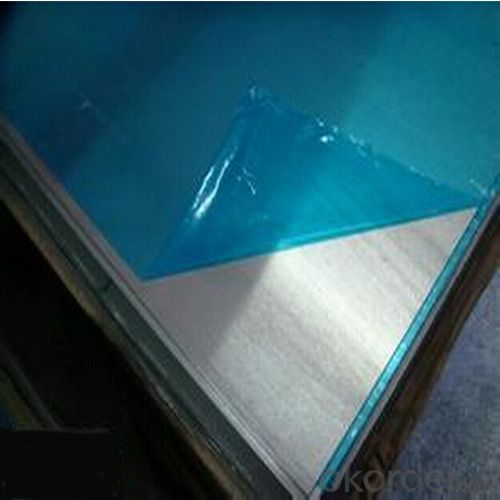
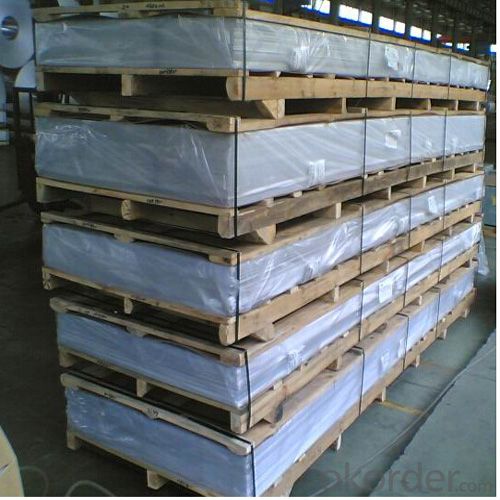
4. Plastic Film Coated Aluminum Sheet Specification:
| Aluminium sheet | |||||
| Alloy No. | Thickness (mm) | Width (mm) | Length (mm) | Temper | |
| A1050,A1060, A1070,A1100 | 0.2-100 | 20-2200 | 20-8000 | O,H12,H22,H14,H16,H18, H24,H26,etc | |
| 3A21,A3003,A3105,A3004 | 0.2-100 | 20-2200 | 20-8000 | O,H14,H18,H24,etc | |
| A5052 ,A5005,A5083,A5754 | 0.2-100 | 20-2200 | 20-8000 | O,H18,H24,H32,H34,H111,H112 ,etc | |
| A6061,A6082,A6063 | 0.2-200 | 20-2200 | 20-8000 | T4,T6, T651,etc | |
| A8011 | 0.2-100 | 20-2200 | 20-8000 | O,H12,H22,H14,H16,H18,H24,H26, etc | |
5.FAQ
1.Q: What about leadtime ?
A: Normally the leadtime is 60days after we receive the deposit and confirm the details. All the press machines we use is the best quality in China Yangli brand. The press machine leadtime from Yangli is 50days, the best leadtime we can give is 60days.
2.Q: What's the lead time for moulds?
A: Normally the mould leadtime is 45 days after we confirm all the details with customer. Our professional mechanical enginners from Austria will design the mould according to the samples from customer, or by the specifications offered by customers.
3.Q:What kinds of mould you can make? and what is your strong point for the moulds?
A: we can make wrinkle wall mould and smooth wall mould both. For wrinkle wall mould we can make, 79" pan, fish pan, bbq pan. For smooth wall mould we can make muffin cup, and cake cup, tar cup,etc. We can also make 2 or 3 portion conatiner moulds as long as you offer us sample or specifications. Our strong points are all our moulds are WEDMLS cut, which makes the mould more accurate and precise. Important materials likestainless steel parts we make in Austria. We also recut after heat treatment, which most of makers do not take this process..
- Q: Explain the distinctions between aluminum sheets and aluminum foil in terms of thickness, uses, and properties.
- <p>Aluminum sheets and aluminum foil are both made from aluminum but differ in thickness and applications. Aluminum sheets are thicker and more rigid, typically used for construction, manufacturing, and as a packaging material. They offer better strength and durability. Aluminum foil, on the other hand, is very thin and flexible, commonly used for food packaging, cooking, and insulation. It's lightweight and has excellent heat and light reflection properties. Aluminum sheets are often anodized or coated for additional properties, while foil is valued for its purity and malleability.</p>
- Q: we have the mass of an aluminum sample =.47g, and the number of atoms in sample =107
- answer is 0.47/107 so each atom weighs 0.004392523364485981308411214953271g that can be rounded to whatever decimal places you want.
- Q: What are the advantages of using aluminum sheet in construction?
- Using aluminum sheet in construction offers several benefits. Firstly, its lightweight composition makes it easy to handle and transport on construction sites, reducing the need for heavy machinery and improving efficiency, ultimately leading to cost savings. Secondly, aluminum exhibits exceptional resistance to corrosion, unlike other metals such as steel, making it a durable and suitable material for outdoor applications like roofing or cladding. Additionally, aluminum's versatility allows for easy shaping and forming into various sizes and profiles, providing architects and engineers with greater design flexibility to create innovative and unique structures. Moreover, aluminum is a sustainable choice as it is 100% recyclable, helping reduce waste and minimize the carbon footprint. Furthermore, it possesses excellent thermal and electrical conductivity properties, reflecting heat and light to maintain comfortable indoor temperatures and reduce energy consumption. It also serves as an excellent conductor of electricity, making it ideal for electrical wiring and building components. Lastly, though aluminum may have a higher initial cost, its low maintenance requirements and long lifespan make it cost-effective in the long run. Structures made with aluminum sheet do not require regular painting or upkeep, saving both time and money. In conclusion, the advantages of utilizing aluminum sheet in construction encompass its lightweight nature, corrosion resistance, versatility, sustainability, thermal and electrical conductivity, and cost-effectiveness, making it highly desirable for a wide array of construction applications.
- Q: What are the different types of surface treatments available for architectural aluminum sheets?
- There are several different types of surface treatments available for architectural aluminum sheets. These treatments are designed to enhance the appearance, durability, and performance of the aluminum, making it suitable for a wide range of architectural applications. One common type of surface treatment is anodizing. Anodizing involves immersing the aluminum sheet in an electrolytic solution and applying an electric current to create a protective oxide layer on the surface. This oxide layer can be dyed to achieve a desired color or left clear for a natural metallic appearance. Anodized aluminum sheets are known for their excellent corrosion resistance, scratch resistance, and color stability. Another type of surface treatment is powder coating. Powder coating involves applying a dry powder electrostatically to the aluminum sheet and then curing it in an oven. The powder melts and fuses to the surface, creating a smooth and durable finish. Powder coating provides excellent color retention, weather resistance, and resistance to chipping and cracking. A third type of surface treatment is PVDF coating. PVDF (polyvinylidene fluoride) coating is a high-performance fluoropolymer resin that is applied to the aluminum sheet through a coil coating process. PVDF coatings offer exceptional resistance to fading, chalking, and chemical attack, making them ideal for exterior applications where color retention and durability are key. Additionally, there are various mechanical surface treatments available for architectural aluminum sheets. These treatments, such as brushing or polishing, can provide a desired texture or reflectivity to the surface. Mechanical treatments can be used to create a brushed, satin, or mirror-like finish, adding aesthetic appeal to the aluminum sheet. In summary, the different types of surface treatments available for architectural aluminum sheets include anodizing, powder coating, PVDF coating, and mechanical treatments. Each treatment offers unique benefits and characteristics, allowing architects and designers to choose the most suitable option for their specific project requirements.
- Q: i heard that aluminum causes Alzheimers and i was wondering if there is any aluminum in tin.
- No Aluminium (Al) is an element with atomic number 13. Tin (Sn) is another element with atomic number 50
- Q: Can the aluminum sheets be used for manufacturing chemical piping systems?
- Yes, aluminum sheets can be used for manufacturing chemical piping systems.
- Q: How does the surface treatment of aluminum sheet affect its appearance?
- The surface treatment of aluminum sheet greatly affects its appearance. Aluminum, in its natural state, has a shiny and reflective surface that can be enhanced or altered through various surface treatments. One common surface treatment for aluminum sheet is anodizing. Anodizing involves creating a protective oxide layer on the surface of the aluminum through an electrochemical process. This treatment can produce a wide range of colors and finishes, from vibrant and opaque to translucent and metallic. Anodized aluminum sheets can have a sleek, modern appearance and are commonly used in architectural and decorative applications. Another surface treatment option is painting or powder coating. These processes involve applying a layer of paint or powder to the aluminum sheet's surface. This treatment allows for customization in terms of color, texture, and finish. Painted or powder-coated aluminum sheets can have a smooth, glossy appearance or a textured, matte finish depending on the desired outcome. This treatment is commonly used in industries such as automotive, aerospace, and construction where aesthetics and durability are important. Further, aluminum sheets can undergo mechanical surface treatments such as brushing or polishing. Brushing involves creating parallel lines on the surface of the sheet using abrasive pads, resulting in a brushed or satin finish. This treatment can give aluminum sheets a contemporary, industrial look. Polishing, on the other hand, involves buffing the surface to a high gloss, mirror-like finish. This treatment is often used for decorative purposes, such as in the production of jewelry or household items. Overall, the surface treatment of aluminum sheet plays a crucial role in determining its appearance. Whether it is anodizing, painting, powder coating, brushing, or polishing, each treatment offers a unique visual effect that can enhance the aesthetic appeal of the aluminum sheet for specific applications and industries.
- Q: Can aluminum sheet be used for architectural applications?
- Yes, aluminum sheet can be used for architectural applications. Aluminum is a versatile material known for its strength, durability, and corrosion resistance. It is commonly used in the construction industry for architectural cladding, roofing, and facades, among other applications. Aluminum sheets are available in various thicknesses, allowing architects and designers to achieve different aesthetic and functional requirements. They can be easily shaped, bent, and formed to create unique architectural elements, such as panels, screens, louvers, and decorative features. Furthermore, aluminum sheets can be coated or finished to enhance their appearance and protect them from environmental factors. Anodizing, powder coating, or painting can be applied to improve the material's resistance to weathering, UV radiation, and pollution. The lightweight nature of aluminum makes it a preferred choice for architectural applications as it reduces the overall weight of the structure and facilitates easier installation. Additionally, aluminum is a sustainable material that can be recycled indefinitely, making it an environmentally friendly option for architectural projects. In conclusion, aluminum sheets are a viable and popular choice for architectural applications due to their strength, versatility, durability, and aesthetic appeal.
- Q: So I got this stainless steel ring but I took it to this place and apparently its not stainless it's aliminum bc of how light it is but it's really hard so how could it be aluminum?
- Aluminum is a quite soft metal, but so is gold. It is true that aluminum is light in weight but magnesium is even lighter and is common enough that a ring could be made of it. Metals can be made harder by adding small amounts of other metals or even by the way it is heat treated. .
- Q: This question asks for a list of various fasteners that are commonly used in the installation process of aluminum sheets.
- <p>There are several types of fasteners used for installing aluminum sheets, including: 1. Self-tapping screws, which create their own threads in the material. 2. Rivets, which join two pieces of material by compressing them together. 3. Pop rivets, a type of rivet that can be installed using a handheld tool. 4. Structural adhesives, which bond the sheets together without visible fasteners. 5. Welding, although not a fastener, it's a method used to join aluminum sheets permanently. 6. Mechanical fasteners like bolts and nuts, which are tightened to secure the sheets. 7. Clips and clamps, used for temporary or decorative installations. Each type has its own advantages and is chosen based on the specific requirements of the installation, such as load-bearing needs, aesthetic considerations, and the environment in which the aluminum sheets will be used.</p>
Send your message to us
High Quality Camo Aluminum Sheets with Plastic Film Coated
- Loading Port:
- Shanghai
- Payment Terms:
- TT OR LC
- Min Order Qty:
- 5 m.t.
- Supply Capability:
- 10000 m.t./month
OKorder Service Pledge
OKorder Financial Service
Similar products
Hot products
Hot Searches
Related keywords
